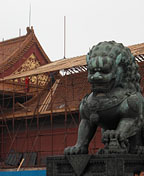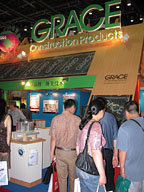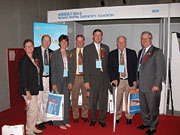
For a number of years much of the news from China has been "all business": from construction of the Three Gorges Dam to the exit of the British from Hong Kong, to recent stories of a rapidly expanding economy exemplified by record construction activity. This construction activity is taking a new bite out of the world's natural resources, including iron ore, coke, cement and oil. China, isolated for so much of its long history, seems to have moved into yet another era with a slant toward modernization and emerging opportunities for entrepreneurs.
When the opportunity arose to travel to the other side of the planet and see first-hand what was going on, how could we resist? The opportunity was the 2004 National Roofing Contractors Association study tour to Beijing, China. Roofing Contractor joined a group of 22, including NRCA staff and a group of roofing contractors and their spouses. The tour was set around the 2nd China International Exhibition for Building Waterproofing Technology, sponsored jointly by the China National Waterproof Building Materials Industry Association (CNWBMIA), China National Building Materials Group Corporation (CNBMGA) and NRCA.

The Exhibition
Only the second trade exhibition attempted by the Chinese waterproofing industry, the show was impressive both in the variety of exhibits and in the sheer number of people and companies in attendance. The trade show was divided into two sections: The main hall was reserved for the larger displays while the other was full of booths with vendors hawking all types of roofing materials, tools and equipment. The main hall had a number of firms exhibiting from the United States, Japan, Germany, and other Asian and European countries.According to Daniel Wan, manager of the international liaison department of CNWBMIA, a total of 17,500 industry professionals attended the exhibition over the course of four days. Attendees included 5,000 contractors, 2,000 foreign visitors, and 3,000 visitors from building materials companies.
CNWBMIA surveyed attendees and found they placed a great deal of value on this unique opportunity to exchange ideas, find solutions, gain knowledge and make important business contacts. No surprise, but that is exactly the kind of thing that roofing contractors in the United States seek when attending conventions, trade shows and seminars here.
The NRCA, as a co-sponsor of the exhibition, participated in several key events and staffed an exhibit for the duration of the exhibition. Executives representing NRCA included Dane Bradford, current president; John Gooding, immediate past-president; Reid Ribble, senior vice-president; Dudley Miles III, past-president; and Bill Good, executive vice-president.
Despite the fact that most of the exhibits featured English-language company names, most did not have English-speaking people in their booths or have brochures printed in English. This problem was largely overcome by one or more interpreters who were available to the tour group, including Ms. Jing Hua, who stayed with the group throughout the duration of the tour in Beijing.
The NRCA began collaborating with the Chinese waterproofing industry years ago and has contributed considerable time and expertise to this event and the sponsoring association. It appears that the Chinese are fast learners because they not only put on a good show, they have attracted the best and brightest in their industry, and many others from all over the world.
As an observer of the industry primarily in the United States, it was more than just a little interesting to visit with some of the Chinese manufacturers and contractors. Their methods run the gamut from the very basic and low-tech, to the more modern systems and materials. Their basic business model and cultural makeup are very different from ours, and we were surprised to learn that the expectation for longevity of a low-slope roof is considerably lower than ours-as little as three to five years. As they adopt newer technologies and methods, this is bound to improve.
Miles said of the Chinese waterproofing industry, "I am impressed with the fact that they value very much their association with NRCA. And as they look for new and better ways to make roofing products and install roofing, I think it's a perfect example of how we can cooperate."

People in the Industry
There exists in the Chinese industry a thirst for knowledge of modern roofing and waterproofing technology. It is clear that there will be a growing demand for foreign-made materials and technologies for years to come, including those from the United States, Europe and other Pacific Rim countries. They are also proud of their industry and anxious to share their technologies with us.Of the Chinese industry, Gooding says, "I wish I had their workers," noting the abundance of people available for work in China. Gooding also commented on the fact that they are still very interested in training and improving their workforce, and in increasing their productivity and quality. Citing the growth that still lies ahead in China, Gooding plans to make some investments there by way of selected mutual funds. He sees some opportunities for U.S. roofing manufacturers and opportunities for contractors if they are willing to develop the relationships that it would take to seek work there.
One of the first things I learned about attending tradeshows as a much younger man was the power what went on outside of the exhibition hall; the time we have to spend with colleagues and associates in the hallways, at mealtimes, and yes, the occasional meeting at places where adult beverages are consumed. On the first evening in China we were treated to a nice dinner hosted by Zou Xianhua, vice president of the CNWBMIA, and other association executives. There we had the opportunity to ask one of the executives, "What is the secret of doing business in China?" He answered through an interpreter, "It is the Guan Xi" (pronounced kwan gee), which loosely translates to "the relationship"-just like in the United States. No real revelation, except we learned that it takes a great deal of time and an understanding of the Chinese culture and ways of doing business to establish "Guan Xi."
One example of an American that has established "Guan Xi" is Curtis Maas, president of manufacturer Reichel & Drews of Itasca, Ill. R&D makes machinery used in the manufacture of all types of asphalt roofing products. The firm traces its business with the Chinese back to the first trip in 1986, followed by the first actual sale and delivery of machinery in the early ‘90s. Maas, whose products were on exhibition at the CNWBMIA, tells us that the relationship with the Chinese really took off when the firm made the decisions to plant roots in China, establishing an office there around 10 years ago with their first employee, Jian Qing Yao. Mr. Yao had a unique blend of experience in the industry together with knowledge of American business and all things Chinese.
The tour group had the opportunity to see some of R&D's machinery in use when we visited the new modified bitumen plant operated by the Beijing Oriental Yuhong Waterproof Technology Co. LTD. It is very much like a modified bitumen plant you would see in the United States or Europe, but with two notable differences. First, each stage of the R&D modified bitumen line has a plaque that displays the name of the machinery and the COST. That is an interesting concept. If you label your equipment, your workers may appreciate it more. The other thing was the fact that all the finished rolls are taken off the end of the line by hand and hand-stacked off pallets. We haven't seen that here in a long, long time.
Our tour was led by Yuhong chairman Weiguo Li. Mr. Li is typical of the rising star in the private sector of Chinese enterprise: He is young, energetic, rightfully proud of the business he is building, and extremely competitive. According to Maas, entrepreneurs in China, such as Li, are capable of running circles around the older state-owned businesses that find it difficult to react to the rapidly changing dynamics of business.
The Museum of Chinese Waterproofing Technology
A pleasant surprise awaited us on visiting the Yuhong facility. On the campus of this active enterprise is a museum devoted to the history of the roofing and waterproofing industry in China. This unique display features room after room of exhibits, beginning with examples of pre-historic shelter and moving on through the ages into thatch, tile and slate.Most of the museum is devoted to the modern waterproofing industry in China. The time we had at the museum was unfortunately short. We did, however, gain more perspective on the industry at the museum than in any of the exhibits at the trade show, because it was not focused on any one material or system, but on the industry as a whole. The museum hosts 12,000 visitors each year.
And if they left anything out, we wouldn't have known it.
Some of the most intriguing parts of the museum included the display of waterproofing failures. Posters and samples of materials showing how certain methods and materials did not make the grade were prominently displayed. We have all heard how the lack of respect for intellectual property and patent rights are a growing problem in China. The museum features an array of counterfeit waterproofing materials, including rolls of what looks like modified bitumen, but is clearly of an inferior quality. Much has been written lately about this issue and how the central government is struggling with ways of dealing with it. It may take a long time to change what seems to be a cultural norm, but the rising generation of entrepreneurs is bound to push for change.
The museum features a report on ties to the former Soviet Union, with whom China had a long relationship, and from whom they received much of the technology still evident in construction and waterproofing today. In contrast, there is a display full of products and systems from all over the world, including the United States and Europe. That Pink Panther is everywhere.
Some Other Things We Learned
The CNWBMIA arranged for us to tour two job sites. As if to show that we are all in the same business, one job visit was cancelled due to rain. Sound familiar? The other sanctioned visit was to the construction site of the new Beijing Opera House. Situated near Tianamen Square and the Forbidden City, this unique structure was designed by a French architect, and for my taste looks a bit out of place. It is an example, however, of what is happening in China today. The push to modernize is discernable, even on a short visit such as this. The site of the new opera house is in an old section of the city that is being revitalized. The metal roof consists of three layers and insulation, and is complemented by a massive skylight on one side. The completed structure will house three separate theaters seating a total of less than 9,000.I do not claim to be an expert on construction of this type, but as a casual observer, it seems that the use of concrete and steel are extreme. Yes, very well built; but a clear contrast to how commercial construction is here, where lighter construction using fewer materials is the order of the day. Sharing the kind of technology that has been developed to be easier on the use of natural resources would seem a good defensive move on the part of countries more developed in this regard. The use of natural resources such as the previously mentioned iron ore, coke, cement and oil will only grow as the Chinese economy continues to expand.
On the lighter side of this study tour, we were treated to tours of the Great Wall, Tianamen Square, the Ming Tombs and the Forbidden City. It was on the tour of the Forbidden City that we veered into one of the most interesting roofing jobs going on in China today. The gilded roofs of the Emperors of China are being retrofitted in advance of the 2008 Summer Olympics and the expected crush of tourists from around the world. Unfortunately we did not have access to information about the scope of the work, but could tell a few things just by observing and some from tour guides. For instance, we could not tell how old the tile roofing was, but knew that the buildings were hundreds of years old. The roofs are gold because this was the palace of the emperor. Each of the hips features nine animals (due to the importance of the buildings), meant to keep away evil spirits and bad luck.
The glazing on the tiles is worn and it appears that the job may be about beautifying; but there may be waterproofing considerations as well. The day we visited, workers were putting temporary roofs over the roofs, presumably to protect the insides of these valuable buildings. It is also likely that this will allow workers 24/7 access to the site.
All the commercial construction jobs in Beijing operate around the clock. This too is said to be part of the push to complete construction well in advance of the 2008 Summer Olympics. How much construction? Bradford and Ribble counted over 400 tower cranes on the cab ride from the downtown hotel to the airport in Beijing. That's over four hundred.
An Amazing Adventure
It is impossible to cover the entire 2004 NRCA Study Tour to China. There were so many sites, so much to learn. And now we know there is so much more to be learned. My world is now smaller and much richer for having had the great opportunity to travel to a far away place and meet people who are so much different and so much the same as us. If you ever have the opportunity to travel to China, I can now recommend it to you.I am sorry to have to leave out details of my side trip to Xian to see the Terra Cotta Warriors and Horses. I can't even tell you about NRCA's extended trip to Hong Kong. Roofing contractor Yvonne Collier told me she may not be able to make the trip again: Being the owner of your own company has its drawbacks when it comes to taking two weeks away. But Collier also freely admits that she has absolutely no regrets for making this trip, and gives credit to the NRCA staff (especially Olicia Hinojosa) for the fact that, "Every step of the way was taken care of."
I share Yvonne's sentiment in that regard, but hope to return some day. It was a trip of a lifetime, and this small report does not do it justice. Next time, you will just have to come and see for yourself.

Report Abusive Comment